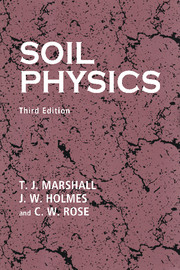Book contents
- Frontmatter
- Contents
- Preface
- Preface to the second edition
- Preface to the first edition
- 1 Composition of soil
- 2 Interaction of soil and water
- 3 Measurement of water content and potential
- 4 Principles of water movement in soil
- 5 Distribution of water in soil
- 6 Ground water in soils and aquifers
- 7 The use of isotopes and other tracers in soil water and groundwater studies
- 8 Soil structure
- 9 Deformation of soil
- 10 Management of soil water
- 11 Soil erosion and conservation
- 12 Chemical transport in soil
- 13 The physical environment of roots
- 14 Plants and soil water
- Appendixes
- References
- Index
9 - Deformation of soil
Published online by Cambridge University Press: 05 June 2012
- Frontmatter
- Contents
- Preface
- Preface to the second edition
- Preface to the first edition
- 1 Composition of soil
- 2 Interaction of soil and water
- 3 Measurement of water content and potential
- 4 Principles of water movement in soil
- 5 Distribution of water in soil
- 6 Ground water in soils and aquifers
- 7 The use of isotopes and other tracers in soil water and groundwater studies
- 8 Soil structure
- 9 Deformation of soil
- 10 Management of soil water
- 11 Soil erosion and conservation
- 12 Chemical transport in soil
- 13 The physical environment of roots
- 14 Plants and soil water
- Appendixes
- References
- Index
Summary
Consistency
The state of soil – whether it is solid, plastic or liquid – is referred to as its consistency. Soil in the plastic state has the property of flowing, after a yield or threshold stress has been exceeded. It differs from a Newtonian fluid such as water which requires no yield stress for flow to occur, and it differs from soil in the solid state in that, under stress, it yields without fracturing. These differences provide the basis for simple tests to find the water content at the upper (wetter) and lower (drier) limits of plasticity of a soil that contains sufficient fine material to show plastic behaviour. The tests devised by Atterberg (1911) and modified by Casagrande are described fully by Sowers (1965), American Society for Testing and Materials (1984), and British Standards Institution (1975). For these tests, soil samples from which particles larger than 2 mm in diameter have been removed are remoulded into a paste after wetting. In standard engineering methods only material smaller than 0.4 mm is used.
The lower limit of plasticity is determined by finding the water content at which soil, rolled into a thread 3 mm in diameter, begins to crumble. This was called the rolling-out limit by Atterberg but is now more usually called the plastic limit. The upper limit of plasticity of a soil (called its liquid limit) is determined either by finding the water content at which a groove formed in the soil will just close under the influence of standardised impacts, or by the method preferred by the British Standards Institution using a cone penetrometer.
- Type
- Chapter
- Information
- Soil Physics , pp. 229 - 247Publisher: Cambridge University PressPrint publication year: 1996



